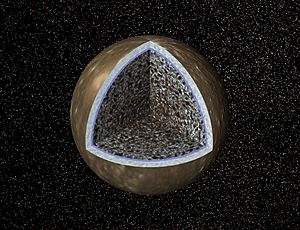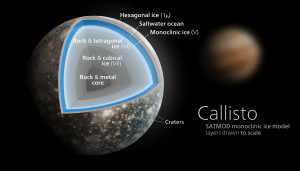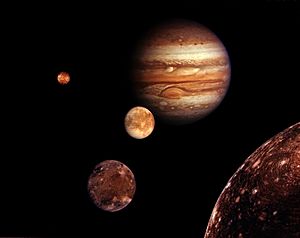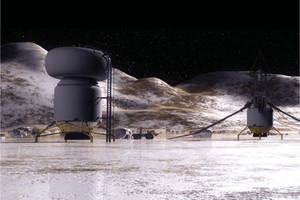Callisto (moon) facts for kids
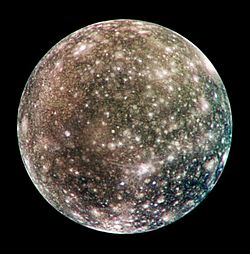
Click image for more information
|
|||||||||
| Discovery | |||||||||
|---|---|---|---|---|---|---|---|---|---|
| Discovered by | G. Galilei S. Marius |
||||||||
| Discovery date | January 7, 1610 | ||||||||
| Orbital characteristics | |||||||||
| Periapsis | 1,869,000 km | ||||||||
| Apoapsis | 1,897,000 km | ||||||||
|
Mean orbit radius
|
1,882,700 km | ||||||||
| Eccentricity | 0.0074 | ||||||||
| 16.6890184 d | |||||||||
|
Average orbital speed
|
8.204 km/s | ||||||||
| Inclination | 0.192° (to Jupiter's equator) | ||||||||
| Satellite of | Jupiter | ||||||||
| Physical characteristics | |||||||||
|
Mean radius
|
2410.3 ± 1.5 km (0.378 Earths) | ||||||||
| 7.30×107 km² (0.143 Earths) | |||||||||
| Volume | 5.9×1010 km³ (0.0541 Earths) | ||||||||
| Mass | 1.075938 ± 0.000137×1023 kg (0.018 Earths) | ||||||||
|
Mean density
|
1.8344 ± 0.0034 g/cm³ | ||||||||
| 1.235 m/s2 (0.126 g) | |||||||||
| 2.440 km/s | |||||||||
| synchronous | |||||||||
| zero | |||||||||
| Albedo | 0.22 (geometric) | ||||||||
|
|||||||||
| 5.65 (opposition) | |||||||||
| Atmosphere | |||||||||
| Composition by volume | ~4×108 cm-3 carbon dioxide up to 2×1010 cm-3 oxygen molecules |
||||||||
Callisto is a moon of the planet Jupiter. It was discovered in 1610 by Galileo Galilei. Callisto is the second largest moon orbiting Jupiter, right after Ganymede. It is also the third largest moon in our entire Solar System. Callisto is almost the same size as the planet Mercury.
Of Jupiter's four largest moons, known as the Galilean moons, Callisto is the farthest one. Like Earth's Moon, Callisto rotates synchronously with its orbit. This means that one side of Callisto always faces Jupiter, while the other side never does. Callisto's surface is less affected by Jupiter's strong magnetosphere compared to the seven moons closer to the planet.
Contents
What Callisto is Like
Callisto is made of about equal amounts of rock and ice. Its surface has water ice, carbon dioxide, and other materials. The Galileo spacecraft studied Callisto closely. It found that Callisto might have a small rocky core. It also suggested there could be a hidden ocean of liquid water more than 100 kilometers (about 62 miles) deep under its surface.
The surface of Callisto is covered in many craters and is very old. The biggest crater is Valhalla, which is 3,000 km (about 1,860 miles) wide. The second largest is Asgard, measuring 1,600 km (about 990 miles) across. Callisto's surface does not show signs of active geology like plate tectonics, earthquakes, or volcanoes. Scientists believe its surface has mostly changed due to meteorite impacts over billions of years.
The surface has unique features like huge multi-ring structures and chains of craters. There are also cliffs and ridges. Up close, the surface looks varied. It has frost on hilltops and darker material in valleys. This battered surface sits on a cold, stiff, icy layer called a lithosphere. This layer is between 80 and 150 km (about 50 to 93 miles) thick. Below it, a salty ocean 150–200 km (about 93 to 124 miles) deep might exist.
Callisto has an extremely thin atmosphere. It is made mostly of carbon dioxide and some oxygen molecules. It also has an ionosphere, which is a layer of charged particles. The possible ocean inside Callisto makes scientists wonder if life could exist there. However, this is thought to be less likely than on Jupiter's moon Europa. Many space probes, from Pioneers 10 and 11 to Galileo and Cassini−Huygens, have studied Callisto. Some even think Callisto could be a good place for humans to set up a base for future exploration of Jupiter's moons.
How Callisto Moves in Space
Callisto is the farthest of Jupiter's four largest moons, known as the Galilean moons. It takes Callisto about 16.7 Earth days to complete one orbit around Jupiter.
Because Callisto is so far from Jupiter, it has never been strongly heated by Jupiter's gravity. This is important for how its inside is built and how it has changed over time. Its distance also means that it gets much less radiation from Jupiter's magnetosphere. The radiation level on Callisto's surface is still more than ten times higher than Earth's natural background radiation.
Could Life Exist on Callisto?
Scientists believe there might be life in Callisto's hidden ocean. Like Europa and Ganymede, and some of Saturn's moons like Enceladus, Mimas, Dione, and Titan, Callisto might have a subsurface ocean of salty water. It's possible that tiny living things, called halophiles, which love salt, could live in this ocean.
The idea that conditions for life, even tiny microbial life, could exist in the salty ocean under Callisto's surface has been discussed. However, the conditions needed for life seem less favorable on Callisto than on Europa.
Future Human Exploration
In 2003, NASA studied the idea of future human exploration of the outer Solar System. This study, called Human Outer Planets Exploration (HOPE), looked closely at Callisto as a possible target.
The study suggested building a base on Callisto. This base could produce rocket propellant to help spacecraft travel even farther into the Solar System. Callisto has several advantages for a base: low radiation (because it's far from Jupiter) and a very stable geology. Such a base could help explore Europa from a distance. It could also be a perfect stop for spacecraft heading deeper into the outer Solar System, using Jupiter's gravity to speed up after leaving Callisto.
In December 2003, NASA announced that a human mission to Callisto might be possible in the 2040s.
Images for kids
-
Callisto (bottom left), Jupiter (top right) and Europa (below and left of Jupiter's Great Red Spot) as viewed by Cassini–Huygens
-
Near-IR spectra of dark cratered plains (red) and the Asgard impact structure (blue), showing the presence of more water ice (absorption bands from 1 to 2 μm) and less rocky material within Asgard.
-
Voyager 1 image of Valhalla, a multi-ring impact structure 3800 km in diameter
-
Two landslides 3–3.5 km long are visible on the right sides of the floors of the two large craters on the right.
-
Views of eroding (top) and mostly eroded (bottom) ice knobs (~100 m high), possibly formed from the ejecta of an ancient impact
See also
 In Spanish: Calisto (satélite) para niños
In Spanish: Calisto (satélite) para niños


